Related Research Articles
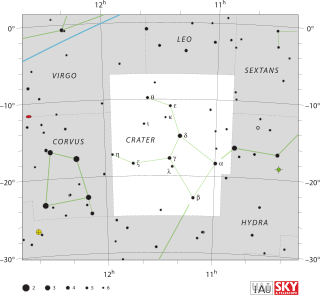
Crater is a small constellation in the southern celestial hemisphere. Its name is the latinization of the Greek krater, a type of cup used to water down wine. One of the 48 constellations listed by the second-century astronomer Ptolemy, it depicts a cup that has been associated with the god Apollo and is perched on the back of Hydra the water snake.
94 Aquarii is a triple star system in the equatorial constellation of Aquarius. 94 Aquarii is the Flamsteed designation. The brightest member has an apparent visual magnitude of 5.19, making it visible to the naked eye. The parallax measured by the Gaia spacecraft yields a distance estimate of around 73 light-years from Earth.
68 Aquarii is a single star located 270 light years away from the Sun in the zodiac constellation of Aquarius. 68 Aquarii is its Flamsteed designation, though it also bears the Bayer designation of g2 Aquarii. It is visible to the naked eye as a dim, yellow-hued star with an apparent visual magnitude of 5.24. The object is moving further from the Earth with a heliocentric radial velocity of +24.5 km/s.
107 Aquarii is a double star in the equatorial constellation of Aquarius. 107 Aquarii is the Flamsteed designation, although it also bears the Bayer designation i2 Aquarii. The pair have an angular separation of 6.787 arcseconds. They have a combined apparent visual magnitude of +5.305, with individual magnitudes of 5.72 and 6.72. The annual parallax shift measured for the two components is 16.1 mas and 20.0 mas respectively, although with significant statistical margins of error and flags for potential unreliability of both values. This indicates the system may be at a distance of 160–200 light-years from Earth.
49 Aquarii, abbreviated 49 Aqr, is a star in the zodiac constellation of Aquarius. 49 Aquarii is its Flamsteed designation. It is a dim star with an apparent visual magnitude of 5.53. The distance to 49 Aqr, as determined from its annual parallax shift of 12.28 mas, is 266 light years. It is moving closer to the Earth with a heliocentric radial velocity of −13 km/s.
44 Aquarii is a single star located 336 light years away from the Sun in the equatorial constellation of Aquarius. 44 Aquarii is its Flamsteed designation. It is visible to the naked eye as a dim, yellow-hued star with an apparent visual magnitude of 5.75. This body is moving away from the Earth with a heliocentric radial velocity of +7.4 km/s.
60 Aquarii is a star located 375 light years away from the Sun in the equatorial constellation of Aquarius. 60 Aquarii is its Flamsteed designation. It is visible to the naked eye as a dim, yellow-hued star with an apparent visual magnitude of 5.89. The star is moving closer to the Earth with a heliocentric radial velocity of –8 km/s.
100 Aquarii is a star in the zodiac constellation of Aquarius. The designation is from the star catalogue of English astronomer John Flamsteed, first published in 1712. It is near the lower limit of visibility to the naked eye, appearing as a dim, yellow-white hued star with an apparent visual magnitude of 6.24. The heliocentric radial velocity is poorly constrained, but the star appears to be moving closer to the Earth at the rate of around −8 km/s.

9 Aurigae is a star system in Auriga (constellation). It has an apparent magnitude of about 5, making it visible to the naked eye in many suburban skies. Parallax estimates made by the Hipparcos spacecraft put it at about 86 light-years from the solar system, although individual Gaia Data Release 3 parallaxes place all three components at 88 light years.
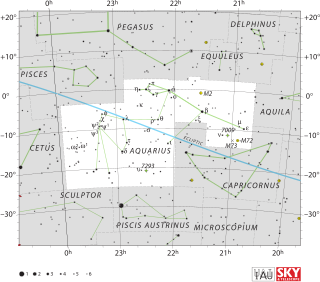
Omega1 Aquarii, Latinized from ω1 Aquarii, is the Bayer designation for a single star in the equatorial constellation of Aquarius. With an apparent visual magnitude of 4.96, this star is faintly visible to the naked eye from the suburbs. The distance to this star can be estimated from the parallax as approximately 138 light-years.
HD 115310, also known by its Bayer designation r Centauri, is a star in the southern constellation Centaurus. It is an orange-hued star that is visible to the naked eye with an apparent visual magnitude that ranges around +5.12. Based upon parallax measurements, it is located approximately 257 light years away. It is drifting further from the Sun with a radial velocity of +12.9 km/s.
HD 224635 and HD 224636 is a pair of stars comprising a binary star system in the constellation Andromeda. They are located approximately 94 light years away and they orbit each other every 717 years.
HD 221776 is a double star in the northern constellation of Andromeda. With an apparent visual magnitude of 6.18, it is viewable by the naked eye user very favourable conditions. The most luminous component has a spectral classification K5III, meaning that it is an orange giant star that has evolved off the main sequence. An infrared excess has been detected around this star, indicating the star is associated with a cloud of dust particles.
27 Hydrae is a triple star system system in the equatorial constellation of Hydra, located 222 light years away from the Sun. It is visible to the naked eye as a faint, orange-hued star with a combined apparent visual magnitude of 4.82. The system is moving further from the Earth with a heliocentric radial velocity of +25.6 km/s.
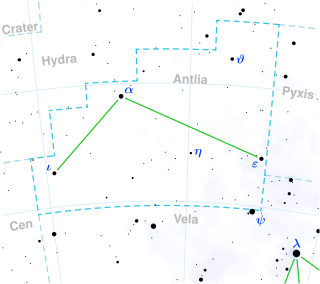
Zeta1 Antliae is the Bayer designation for a binary star system in the southern constellation of Antlia. Based upon parallax measurements, the pair are located at a distance of roughly 350 light-years from Earth. They have apparent magnitudes of +6.20 and +7.01 and are separated by 8.042 arcseconds. The apparent magnitude of the combined system is +5.76, which is bright enough to be seen with the naked eye in suitably dark skies.
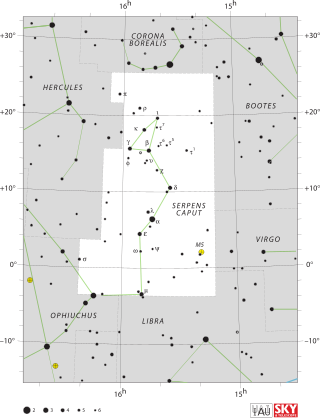
1 Serpentis is a red giant in the constellation Virgo with an apparent magnitude of 5.5. It is a red clump giant, a cool horizontal branch star that is fusing helium in its core. It has expanded to over 13 times the radius of the Sun and although it is cooler at 4,581 K it is 77 times more luminous. It is 322 light years away.
HD 102350 is a single star in the constellation Centaurus. It has a yellow hue and is visible to the naked eye with an apparent visual magnitude of 4.11. The distance to this star is approximately 390 light years based on parallax, but it is drifting closer with a radial velocity of −3 km/s. It has an absolute magnitude of −1.51.
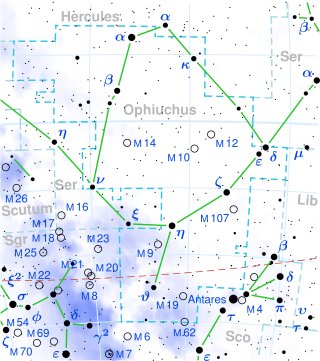
71 Ophiuchi is a single star in the equatorial constellation of Ophiuchus. It is visible to the naked eye as a faint, yellow-hued point of light with an apparent visual magnitude of 4.64. The star is located approximately 273 light years away from the Sun based on parallax, and is moving closer with a radial velocity of −3 km/s.
H Velorum is a triple star system in the constellation Vela, at a distance of approximately 390 light years.
Eta Microscopii, Latinised as η Microscopii, is a solitary star in the constellation Microscopium. It is visible to the naked eye as a dim, orange-hued star with an apparent visual magnitude of 5.53. The star is located around 910 light-years distant from the Sun based on parallax, and is drifting further away with a radial velocity of +22 km/s.
References
- 1 2 van Leeuwen, F. (November 2007), "Validation of the new Hipparcos reduction", Astronomy and Astrophysics, 474 (2): 653–664, arXiv: 0708.1752 , Bibcode:2007A&A...474..653V, doi:10.1051/0004-6361:20078357, S2CID 18759600.
- 1 2 3 4 Rakos, K. D.; et al. (February 1982), "Photometric and astrometric observations of close visual binaries", Astronomy and Astrophysics Supplement Series, 47: 221–235, Bibcode:1982A&AS...47..221R.
- 1 2 3 4 Eggleton, P. P.; Tokovinin, A. A. (September 2008), "A catalogue of multiplicity among bright stellar systems", Monthly Notices of the Royal Astronomical Society , 389 (2): 869–879, arXiv: 0806.2878 , Bibcode:2008MNRAS.389..869E, doi: 10.1111/j.1365-2966.2008.13596.x , S2CID 14878976.
- 1 2 3 4 5 6 7 8 9 Brown, A. G. A.; et al. (Gaia collaboration) (August 2018). "Gaia Data Release 2: Summary of the contents and survey properties". Astronomy & Astrophysics . 616. A1. arXiv: 1804.09365 . Bibcode: 2018A&A...616A...1G . doi: 10.1051/0004-6361/201833051 . Gaia DR2 record for this source at VizieR.
- 1 2 3 4 5 6 7 8 9 Brown, A. G. A.; et al. (Gaia collaboration) (August 2018). "Gaia Data Release 2: Summary of the contents and survey properties". Astronomy & Astrophysics . 616. A1. arXiv: 1804.09365 . Bibcode: 2018A&A...616A...1G . doi: 10.1051/0004-6361/201833051 . Gaia DR2 record for this source at VizieR.
- 1 2 3 4 McWilliam, Andrew (December 1990), "High-resolution spectroscopic survey of 671 GK giants", Astrophysical Journal Supplement Series, 74: 1075–1128, Bibcode:1990ApJS...74.1075M, doi: 10.1086/191527 .
- ↑ "41 Aqr -- Star in double system", SIMBAD Astronomical Database, Centre de Données astronomiques de Strasbourg , retrieved 2012-02-23.
- ↑ Alves, David R. (August 2000), "K-Band Calibration of the Red Clump Luminosity", The Astrophysical Journal, 539 (2): 732–741, arXiv: astro-ph/0003329 , Bibcode:2000ApJ...539..732A, doi:10.1086/309278, S2CID 16673121.